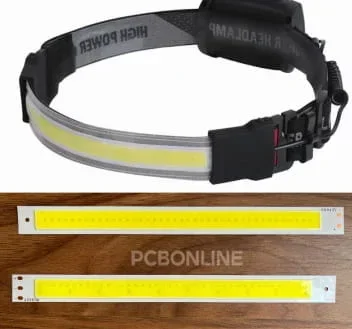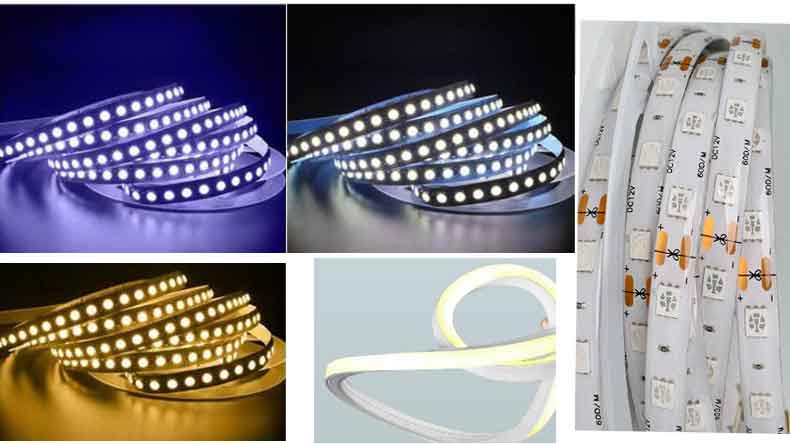
OEM, or original equipment manufacturing, is a popular electronic contract manufacturing mode, where the client provides the design of the product, and the manufacturer completes the electronics manufacturing from prototype to batch production under the client's brand.
Flexible PCBs (printed circuit boards) are thin and lightweight PI or PET-based circuit boards. They support and connect components and are the backbone of flexible electronic products. The core of flexible electronics production is OEM flexible PCB.
PCBONLINE, an OEM PCBA manufacturer, provides OEM flexible PCBs to build flexible electronic products custom for solution/end-terminal companies.
What Is an OEM Flexible PCB?
An OEM flexible PCB is a custom-designed flexible printed circuit manufactured by an original equipment manufacturer for another company's end product.
Unlike rigid PCBs, which use FR4, aluminum, copper, or ceramic substrates, flexible PCBs are built on polyimide (PI) or polyester (PET) films, allowing them to bend, twist, or fold without losing electrical integrity.
When flexible circuits are produced by an OEM manufacturer like PCBONLINE, the process includes:
- Design collaboration with the client to optimize the flexible PCB and product for manufacturability.
- Materials and components procurement for OEM assembly.
- Flex PCB fabrication and assembly, including SMT and through-hole component mounting.
- Electrical testing and final quality assurance before delivery.
OEM flexible PCB manufacturing ensures that your flexible electronics are custom-engineered and production-ready, matching both electrical performance and mechanical reliability requirements.
The Structure and Materials of Flexible PCBs
The performance of a flex PCB heavily depends on its materials and layer structure.
A single-layer flexible PCB includes:
- Base material: Polyimide film (such as DuPont Kapton), providing heat resistance and flexibility.
- Adhesive layer: Acrylic or epoxy adhesive bonds the copper foil to the base.
- Copper foil: Conductive layer forming the circuit traces.
- Protective coverlay: Polyimide + adhesive film laminated over the copper to insulate and protect the circuit.
For more complex applications, double-layer and multi-layer flexible PCBs can include:
- Rigid-flex structures, where rigid FR4 PCB layers and flexible PCB layers are laminated into one PCB stack-up.
- Stiffeners (FR4, PI, or stainless steel) to support component areas or connectors.
By using a flexible PCB, the circuit can achieve 3D interconnection within compact enclosures. Flex PCBs are used for medical devices, wearable electronics, aerospace systems, and automotive sensors.
How OEM Flexible PCB Manufacturing Works
The OEM manufacturing process for flexible circuits is material-sensitive and precision-dependent.

Step 1. Design and DFM optimization
The process starts from the client's schematic or design requirements. PCBONLINE's OEM engineering team runs Design for Manufacturability (DFM) checks to ensure:
- Trace widths and spacing meet manufacturing tolerances.
- Bend radius and flex zones avoid copper cracking.
- Via locations don't overlap bending areas.
- Stiffeners and connectors are placed strategically.
At this stage, our engineers may suggest modifications to improve mechanical endurance and assembly reliability.
Step 2. Material preparation and circuit imaging
The polyimide substrate is cleaned and laminated with rolled annealed copper foil. The copper pattern is then transferred using photoimaging or laser direct imaging (LDI).

Step 3. Etching and coverlay application
After patterning, unwanted copper is etched away to form the circuit traces.
A coverlay film (polyimide + adhesive) is then laminated onto the flex surface to protect the traces and define openings for pads.
Step 4. Drilling and plating
Microvias or through-holes are drilled (mechanically or by laser), then electroless copper plating is applied to form interlayer connections.
Step 5. Surface finish
To enhance solderability, the exposed copper pads are surface-finished using ENIG, OSP, or immersion tin/silver, depending on the client's requirements.
Step 6. Component assembly
For flex PCB assembly, the OEM performs SMT (surface-mount technology) on flexible panels supported by carriers or vacuum fixtures.

Low-temperature solder pastes and controlled reflow profiles are used to avoid substrate deformation.
Step 7. Electrical testing and final inspection
100% of the circuits are E-tested for continuity and isolation, followed by AOI inspection, functional testing, and final packaging according to the client's delivery standards.
Advantages of OEM Flexible PCB Manufacturing
OEM flexible PCB manufacturing offers many advantages.
Design freedom: Flexible circuits allow 3D installation, replacing multiple rigid PCBs and connectors with a single flexible interconnect.
Enhanced reliability: By eliminating connectors and solder joints between separate boards, flex PCBs improve signal integrity and vibration resistance—crucial in automotive, aerospace, and wearable systems.
Lightweight and thin: A flex PCB weighs 75% less and is up to 90% thinner than equivalent rigid board assemblies.
Customization for complex systems: OEM manufacturing enables custom-tailored designs. You can specify thickness, bend radius, number of layers, and even mixed rigid-flex structures.
Streamlined production and quality control: OEM flexible PCB manufacturers integrate fabrication and assembly under one roof, ensuring consistent material handling.
Common Applications of Flexible Electronics
OEM flexible PCBs are now widely used in both industrial and consumer fields.

- Medical: Wearable ECG sensors, endoscopic imaging modules, hearing aids
- Automotive: LED lighting interconnects, airbag sensors, battery cell connection systems
- Consumer electronics: Foldable smartphones, cameras, smartwatches, display interconnects
- Aerospace and defense: Avionics control systems, satellite modules, antenna arrays
- Industrial control: Flexible connectors in robotic arms, compact control boards
What's more, we helped our client to optimize the product design by switching the light position from the inside top to the inside bottom for effective UV lighting on the eyelash.
Design Considerations for OEM Flex PCBs
When developing a custom flexible PCB with an OEM manufacturer like PCBONLINE, evaluate the following:
- Minimum bend radius: ≥10× the flex thickness for dynamic bending.
- Trace routing: Curved traces preferred; sharp corners can cause stress fractures.
- Copper foil selection: For frequent-bending applications, RA copper is recommended.
- Stiffener placement: Add FR4 or PI stiffeners under connectors or components to prevent mechanical stress.
- Assembly process: Ensure component areas are flat and supported during reflow to avoid warping.
- Surface finish: ENIG or immersion silver recommended for fine-pitch SMT components.
Partner with PCBONLINE for Flexible Electronics OEM
Since the foundation in 2005, PCBONLINE has been committed to turnkey OEM PCBA for more than two decades and served terminal and design clients from around the globe, including Fortune 500 ones in automotive, industrial controls, and computer, R&D companies in IoT and AI, and startups in consumer, industrial control, automotive, and medical electronics.
Our turnkey OEM PCBA services offer:
- Turnkey PCBA manufacturing: From PCB ptototypes and testing to mass PCBA and box-build assembly, our PCB assembly services are custom and one-stop.
- Complete procurement: We source and customize enclosures, cables, and accessories from reliable suppliers.
- Engineering support: We check enclosure and accessory designs for compatibility with your PCBA and can suggest design changes.
- Free DFM/DFT: We provide free Design for Manufacturability (DFM) and Design for Testability (DFT) checks to ensure that designs are optimized for a smooth production process.
- Quality assurance: IPC-A-610 Class 3, automotive-grade or industrial-grade inspection standards.
- Turnkey delivery: From PCB fabrication to final product packaging and shipping.

PCBONLINE manufactures, assembles, and tests flexible PCBs and PCBAs to box builds as a source factory manufacturer under one roof, from prototypes to bulky production, saving costs and time for you.
We have powerful manufacturing strength for flex PCBs and high-end assemblies, such as PI flex PCBs of 1 to 8 layers, PET flex PCBs of 1 to 6 layers, transparent PCBs, waterproof sealing, and flexible PCB assembly.
We can precisely control reflow/wave oven temperatures, design PCBA fixtures, and help create user manuals, installation guides, and compliance labels.
Our high-quality PCBA contract manufacturing is certified with ISO 9001:2015, ISO 14001:2015, IATF 16949:2016, RoHS, REACH, UL, and IPC-A-610 Class 2/3.
Our one-on-one free and professional DFM helps you debug and improve design, to ensure the manufacturability, cost-effectiveness, and final device success.
Whether you need flexible OEM PCB assembly for consumer electronics, AI wearables, IoT devices, creative electronic products, medical-grade products, or automotive CCS, we can deliver the flexible PCBAs of high quality and in time, meeting any of your project requirements. To get a quote for your flexible electronics OEM project, email us at info@pcbonline.com.
Conclusion
OEM flexible PCB services cover all the flexible electronics manufacturing steps and materials. From samples to final product mass production, PCBONLINE ensures that your flexible device is manufactured under one roof with high quality. With more than 20 years of electronic manufacturing experience in OEM flex PCBA, we are ready to check your Gerber and provide flexible electronics OEM services for you. Contact us today!
PCB assembly at PCBONLINE.pdf




